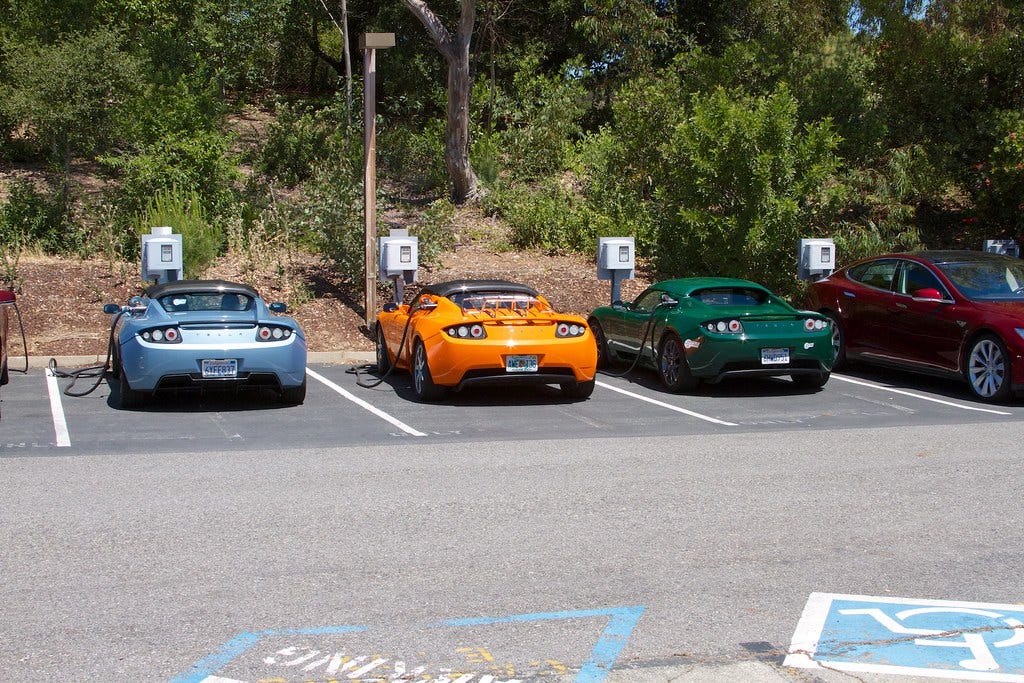Elon Aside, EVs are the Way Forward
Investments in EV infrastructure can help fight climate change while also sparking visits to rural Oregon communities
The resident teenager in my house is dying for a Tesla or, as a possible alternative, any other electric car. Me? Not so much. “But, Kim,” you say, “Aren’t you concerned about global climate change? The use of fossil fuels heating the planet, the droughts, the ‘heat domes,’ the wildfires, floods, melting glaciers, rising oceans?” Yes, definitely yes. So, what’s the hang up? It’s an emotional one.
I have a visceral emotional reaction to Elon Musk, Tesla’s famous CEO. The guy has all but turned me off of electric vehicles, simply by association. He’s like a show-off middle schooler with unlimited funds. I mean, the price of the Tesla Model S? $69,420, which incorporates both a sex joke and a weed joke. (Seriously. Look it up in this article from a year ago, here. ). And the identifiers he’s chosen for the Tesla models are Model S, Model 3, Model X and Model Y. That’s models S3XY. This is from a full-grown adult man.
But I’m going to have to get over myself, get past my emotional reaction to Musk and Tesla, and the grudge I hold against the associated industry. The facts are becoming increasingly clear: The benefits of electric vehicles (EVs) and the infrastructure that makes them possible are a boon for Oregon and rural Oregon in particular.
I urge fellow skeptics to consider these things:
Electric vehicles are cheaper to own and maintain. When you combine savings on fuel, maintenance and repair, and depreciation, EVs win the money game. That’s particularly true for rural drivers who drive up to 10 times more each day than urban drivers.
In Oregon, the electricity that charges those EVs is about as carbon free as you’re going to get. Oregon’s power as a whole is generated mostly by hydro and right in our own state, arguably the greenest green power available at scale, with no heat-inducing carbon emissions*. And on the eastern side of the state, where I live, the local power cooperative gets its power almost entirely from hydro sources (85% hydro, 10% nuclear, 5% from carbon-producing sources). Interestingly, when compared with the mix of power sources used to serve the I-5 Corridor, the electricity that’s charging my Eastern Oregon iPhone, laptop, tablet, and every other power-hungry thing is carbon-free-er than the power charging Oregon’s metro areas (only 40% hydro generation from Portland General Electric). Take that, groovy Willamette Valley Prius-owners.
EV charging stations can be an economic driver in small towns. As EV ownership increases, so does the need for fast-charging charge stations across the state. The Biden administration has set a target of 50% of vehicles being electric by 2030. That’s a lot of EV drivers going from one place to another. While charging time varies depending on model, manufacturers often state that it takes “30 minutes to get to 80%” full. So, if a small town gives travelers a reason to stop by placing a charging station on or near Main Street, they’ve got a captive audience for a half an hour in their retail center. Lunch? Coffee? Some light retail therapy to pass the time? Yes, please. And thank you for your out-of-town dollars. Now be on your way.
Electric vehicles have more available horse-power than their gas or diesel counterparts. This is where I lean on my electrical engineer husband to help explain. Here’s his brief explanation, “Electric motors can provide as much or more horsepower and more importantly high torque. Electric motors are widely used in industrial applications. Large earth movers and locomotives are predominantly driven by electric motors harnessed to diesel generators. The new Ford F150 Lightning will have 563 HP that is compared to the V8 equipped truck with a 400 HP engine. The concern about performance evaporates when you get behind the wheel. The power is instantaneous.”
This may be a hard sell. Some rancher friends of mine have a deeply held belief that no electric truck is ever going to have the power to replace their diesel machines. One Ford F-150 on the market isn’t enough to change that perception. Plus, electric vehicles marketed to environmentally aware urban drivers are seen as a badge of the other team to right-leaning consumers. These considerations are just as emotion-driven as my deep dislike of Elon Musk. If the industry and the Administration can focus on nuts and bolts benefits, maybe skeptics like myself are more likely to listen.
*I know there is controversy around dams and whether the good is off-set by the bad. For my purposes here, I highlight the fact that hydro-generated electricity does not throw carbon into the atmosphere as a by-product of its generation.
Attorney advising non-profit and government entities, some courtroom practice, teacher of Criminal Justice for 9 years. Passionate about local civic involvement. Fifth-generation Eastern Oregonian. I love this place and its people.
"Tesla Visit 2" by oskay is licensed under CC BY 2.0



I think about what it would take to better electrify rural america and maybe pickup trucks shouldn't be the first step. Electric tractors? Less maintenance, more torque, nearby charger and swappable packs, the added weight of batteries could be a benefit as well.